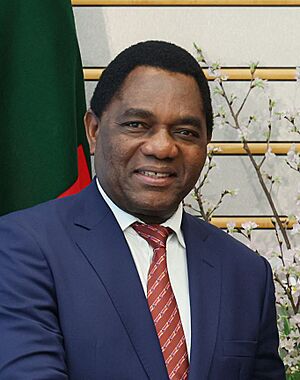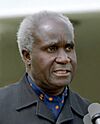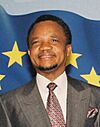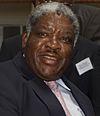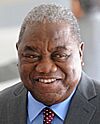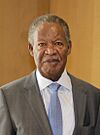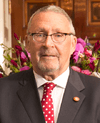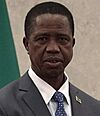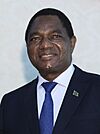President of Zambia facts for kids
Quick facts for kids President of theRepublic of Zambia |
|
|---|---|

Presidential flag
|
|
| Residence | State House |
| Term length | Five years,
renewable once
|
| Constituting instrument | Constitution of Zambia (1991) |
| Inaugural holder | Kenneth Kaunda |
| Formation | 24 October 1964 |
| Deputy | Vice-President of Zambia |
| Salary | 1,280,299 Zambian kwacha/63,100 USD annually |
The President of Zambia is the country's main leader. This person is both the head of state (representing the country) and the head of government (running the government). The president has the highest power in Zambia.
People in Zambia vote for their president. The president serves for five years and can be re-elected once. This important job started when Zambia became an independent country in 1964. The current president is Hakainde Hichilema. He became president on August 24, 2021, after his party, the United Party for National Development, won the election. The president chooses the Cabinet (a group of top advisors). They also lead the Zambian Defence Force and make sure laws are followed.
The first president was Kenneth Kaunda in 1964. After him, six other people have been president since 1991. These include Frederick Chiluba, Levy Mwanawasa, Rupiah Banda, Michael Sata, Edgar Lungu, and the current president, Hakainde Hichilema. Also, Guy Scott was an acting president for a short time after President Michael Sata passed away.
Since August 31, 1991, the president has also been the head of government. Before this, there was a Prime Minister. But that job was removed just before Kaunda left office.
Contents
How Long Does a President Serve?
A president in Zambia is elected for a five-year term. Since 1991, the Constitution of Zambia says that a president can only serve two terms. There was an attempt in 2001 to let President Chiluba serve more terms, but it did not happen.
A Look at Zambia's Presidential History
Early Days: Northern Rhodesia
Before Zambia became independent, it was a British colony called Northern Rhodesia. The leader was the British Monarch. A Governor of Northern Rhodesia represented the Monarch and held all the power.
In 1964, before independence, the job of Prime Minister of Northern Rhodesia was created. This person became the head of government. On May 19, 1964, it was announced that Northern Rhodesia would become independent with a president. The first president was chosen by the elected members of the Legislative Council.
Zambia's Independence and Beyond
When Northern Rhodesia became independent and was renamed Zambia, Prime Minister Kenneth Kaunda was elected as the first president. The job of Prime Minister was then removed. This made the president the main leader.
At first, Zambia was a country with many political parties. But in 1973, President Kaunda changed the Constitution of Zambia. He made Zambia a one-party state. This meant his party, the United National Independence Party (UNIP), was the only legal party. Kaunda said this was to stop tribalism (groups favoring their own tribe). The constitution also brought back the job of Prime Minister. In the 1973 election, people could only vote for or against Kaunda.
Kaunda was re-elected many times without opposition until 1991. In the 1980s, people wanted more political parties. After talks with the Movement for Multi-Party Democracy (MMD) in 1990, President Kaunda allowed other political parties again. The Prime Minister's job was removed once more, and the president got those powers back. In the 1991 Zambian general election, Kaunda lost to Frederick Chiluba of the MMD. Kaunda peacefully gave up power. This was a rare event for an African leader at that time.
In 1996, President Chiluba believed there was a plan by UNIP members to overthrow the government. He declared a state of emergency and arrested some UNIP members. However, the Supreme Court of Zambia said this was not allowed. They ended the state of emergency and released those arrested. Later that year, Chiluba changed the constitution. It said that only people with at least one parent born in Zambia could run for president. This change seemed to be aimed at stopping Kaunda from running again, as his parents were born in Nyasaland (now Malawi).
Because of the two-term limit, Levy Mwanawasa was chosen by Chiluba to be the MMD's next presidential candidate. Mwanawasa won the 2001 Zambian general election. However, other parties said there was election fraud. After legal arguments, the Supreme Court decided in 2005 that even though there were problems, they were not enough to change the election result. Mwanawasa won re-election in 2006. He passed away in 2008 and was replaced by Rupiah Banda. In the 2011 Zambian general election, Banda lost to Michael Sata of the Patriotic Front (PF).
President Sata passed away while in office in 2014. His Vice-President, Guy Scott, became acting president. Scott was the first white head of state in an African country since 1994. However, because his parents were not born in Zambia, the constitution only allowed him to be acting president for 90 days. He could not run for election. In the 2015 Zambian presidential election, Edgar Lungu of the PF won the presidency. He won again a year later in the 2016 general election.
In January 2016, some important changes were made to the constitution.
- First, the rule about parents being born in Zambia for presidential candidates was removed.
- Second, the way presidents are elected changed. Now, a candidate needs more than 50% of the votes to win. If no one gets over 50%, a second election is held between the top two candidates.
- Third, the president and vice-president now run for election together as a team. Before, the president would choose the vice-president after winning.
- Fourth, presidential candidates now need to show they have at least 100 registered voters supporting them in each of Zambia's ten provinces.
In 2020, President Lungu tried to change the constitution again. He wanted the president to be able to change election laws and control Zambia's money. But this change, called Bill 10, failed. The Parliament of Zambia did not vote for it with the needed two-thirds majority.
Who Has Been President?
Here is a list of Zambia's presidents and how long they served.
- Political parties
- United National Independence Party (UNIP)
- Movement for Multi-Party Democracy (MMD)
- Patriotic Front (PF)
- United Party for National Development (UPND)
- Status
- This means an acting president
- Symbols
- Elected without anyone running against them
- Passed away while in office
| No. | Picture | Name (Born–Died) |
Elected | Time in Office | Political party | ||
|---|---|---|---|---|---|---|---|
| Started | Ended | Total Time | |||||
| 1 | Kenneth Kaunda (1924–2021) |
1968 1973 1978 1983 1988 |
24 October 1964 | 2 November 1991 | 27 years, 9 days | UNIP | |
| 2 | Frederick Chiluba (1943–2011) |
1991 1996 |
2 November 1991 | 2 January 2002 | 10 years, 61 days | MMD | |
| 3 | Levy Mwanawasa (1948–2008) |
2001 2006 |
2 January 2002 | 19 August 2008 | 6 years, 230 days | MMD | |
| – | Rupiah Banda (1937–2022) |
– | 19 August 2008 | 2 November 2008 | 75 days | MMD | |
| 4 | 2008 | 2 November 2008 | 23 September 2011 | 2 years, 325 days | |||
| 5 | Michael Sata (1937–2014) |
2011 | 23 September 2011 | 28 October 2014 | 3 years, 35 days | PF | |
| – | Guy Scott (born 1944) |
– | 28 October 2014 | 25 January 2015 | 89 days | PF | |
| 6 | Edgar Lungu (1956–2025) |
2015 2016 |
25 January 2015 | 24 August 2021 | 6 years, 211 days | PF | |
| 7 | Hakainde Hichilema (born 1962) |
2021 | 24 August 2021 | Incumbent | 4 years, 14 days | UPND | |
Timeline of Presidents

How Long Presidents Served
| President | Time in office |
|---|---|
| Kenneth Kaunda | 27 years, 9 days |
| Frederick Chiluba | 10 years, 61 days |
| Levy Mwanawasa | 6 years, 230 days |
| Rupiah Banda | 2 years, 325 days |
| Michael Sata | 3 years, 35 days |
| Edgar Lungu | 6 years, 211 days |
| Hakainde Hichilema | 4 years, 14 days |
| Rupiah Banda | 75 days (acting) |
| Guy Scott | 89 days (acting) |
More to Explore
- First Lady of Zambia
- Vice-President of Zambia
- Governor of Northern Rhodesia
- Prime Minister of Zambia
- List of current heads of state and government
- Bibliography of the history of Zambia
See also
 In Spanish: Presidente de Zambia para niños
In Spanish: Presidente de Zambia para niños


